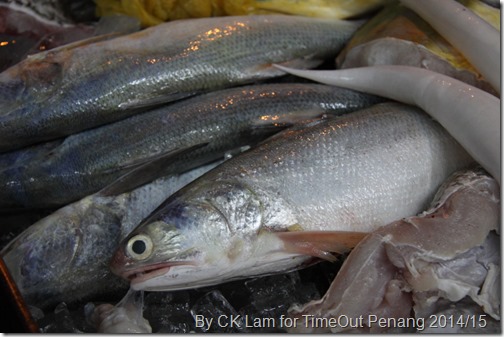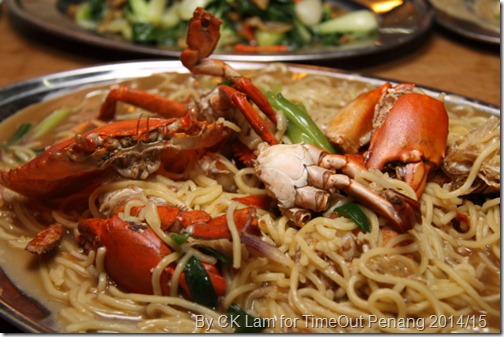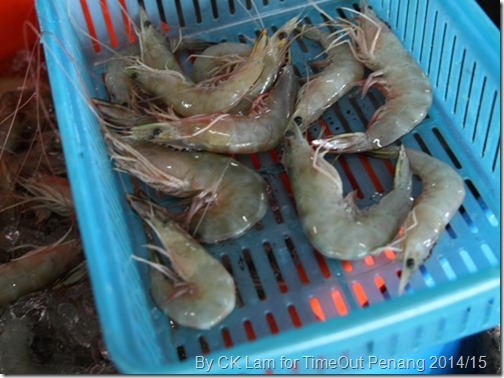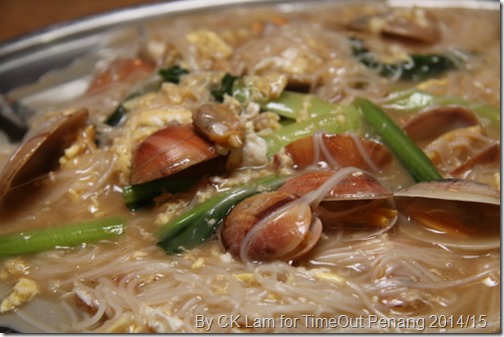Penang Seafood Guide
BY CK Lam
Penang is a food haven and the variety ranges from appetizing hawker food, contemporary cuisine and of course, seafood. For those craving seafood meals, you’re spoilt for choice with the many seafood restaurants on both the mainland and the island.
Just ask around and the locals will proudly recommend their seafood places. There are some right on the beach with views of fishing boats and fishermen hauling in the day’s catch. However, if you prefer dining indoors with air-conditioning, there are many restaurants conveniently located within Penang towns.
There is a comprehensive selection of seafood to choose from in the display counter of seafood restaurants such as crabs, mussels, prawns, clams, fish, oysters and many more. Whether you want them grilled, steamed, chilled, deep-fried or baked, choosing fresh seafood can take some time. Fear not, here are a few tips that will help you order the best seafood meal you’ve ever had.
Choosing Fresh Fish
Start with looking for those with bright clear eyes, vibrant red gills under the flaps on both sides of the head, shiny scales on the skin and of course firm flesh. Another factor not to miss is the odour.
Fishes, especially those fresh off the boat, are odourless while stinky-sourish odour indicates a bad one.
Steamed Fish Styles
There are many ways to cook the fish. Steaming is a healthy choice and the common types of fish good for this coking style will be seabass, snapper and pomfret. Nyonya, Thai and Teochew styles are the popular choices.
Salted (sour) plums, salted vegetables, tomatoes and ginger are the main ingredients for the sourish-salty Teochew style.
For Nyonya style, do expect spiciness from bird’s eye chilli and fragrant flavour from lemongrass. Additional herbs such as ginger flower are added for that subtle piquancy.
Thai steaming style uses fresh herbs such as galangal, lemongrass, kaffir lime leaves, spicy bird’s eye chillies and lime that make a great tangy-spicy gravy.
Then there’s the simple Chinese style flavoured by soy sauce, ginger and spring onions that appeals to those with a more delicate palate.
Other Fish Dishes
Fish grilled over a charcoal fire, known as ikan panggang, is also popular. Many restaurants offer dipping sauces of chilli paste or tamarind juice topped with chopped shallots and chilli.
Stingray or meaty mackerel are perfect for the cooking style that gives a barbecued-smoky flavour.
For the adventurous ones, do check out the fish head curry. This classic fish dish goes well with white rice. Snapper or threadfin fish head are common for this dish. Coconut milk, spices and aromatic curry leaves make up the thick creamy curry with a slight tang and vegetables such as okra, onions and tomatoes are added too.
Choosing Crabs
A general thumb rule, when selecting crabs, is to go for the weight of the crab rather than the size. Squeeze the back of the shell – if it is brittle, the crab would most probably be less meaty. Make sure all their limbs are intact and the shells are not cracked.
Commonly, the flesh of the crab turns mushy after the crab dies, so if the meat that you are consuming is mushy, the crab is no longer fresh. Choosing the gender of the crab is fairly straightforward – the male has a trianglular-shaped flap on his underside while the female comes with a smooth oval-shaped flap.
There are several varieties crab varieties. The more common ones are the lively mud crabs while the flower crabs (known as ‘cheek’ in Penang Hokkien) are easily spotted with blue markings on their shells.

Crab Dishes
Popular, finger-licking good crab dishes are charcoal-baked crabs, stir-fried noodles with crabs and sweet and sour crabs. Some restaurants serve baked crabs with condiments of fresh cucumber and pickles while others serve it plain because it is simply delicious on its own, with the intense smoky flavour.
Sweet and sour crabs come steeping in gooey sauce that’s good to sop up with steamed buns or what the locals call mantou and pieces of toast. Crab-eating is messy business and that’s why some places provide bibs to avoid splatter.
Stir-fried yellow noodle with crabs
Choosing Prawns
Prawns are some of the most versatile seafood and there are many different prawn type and sizes in Penang. The common large ones are called king prawns, followed by tiger prawns. Both are big and juicy, and readily available in seafood restaurants.
When you’re choosing prawns, look out for any black discolouration round the head or legs. Fresh prawns should not have these markings but instead have good bright colours and a fresh, clean smell.
Prawn Dishes
Due to its versatility, there are numerous ways of cooking this shellfish. Besides grilled and steamed, it also goes well with sweet and sour sauce, spicy sambal, black pepper sauce and curry.
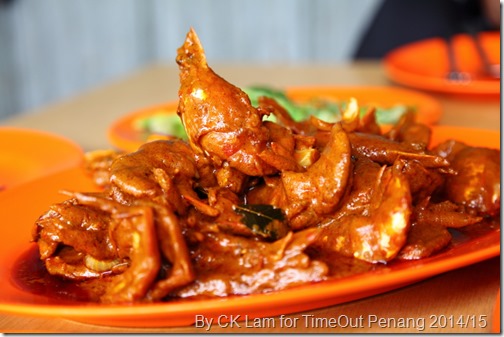
Prawns cooked in curry
In Penang, the Nyonya style stir-fried assam prawn dish is a firm favourite and they marinate prawns with shells intact in tamarind pulp, salt and sugar. The assam heh, as the locals call it, is thick with zesty tamarind flavour and dark soya sauce which accentuates the delicate sweet flavour of the prawns. The gravy-coated prawn shells are tasty to suck on as well. This dish will definitely keep you wanting more.
Other Types of Prawns and Cooking Styles
The mantis prawns are good eaten cold straight out of their shells. The intensely sweet flavour they possess goes well when dipped in chili sauce.

Steamed mantis prawns
Seafood lovers should not miss out on the freshwater prawns commonly known as udang galah. Although highly regarded for its sweet and succulent flesh, it’s actually the roe-filled heads that make up half the size and weight of the prawn that locals love.
Freshwater prawns are good for steaming. A favourite dish is one of these prawns steamed with egg white, ginger and Chinese wine. The best part is the gravy which complements a bowl of white rice perfectly.
Definitely don’t miss these prawns cooked in curry. Fresh spices and curry leaves in the gravy pack a punch of roboust, fiery flavours. Don’t forget to sop up the thick fragrant curry with bread.
Clams and Oyster dishes
Commonly served in Chinese restaurants, this shellfish is often cooked with chilli, coriander, garlic, parsley, tomato and white wine. The slim, long bamboo clams are juicy with a chewy texture and often stir-fried with brown beans, ginger, garlic and spring onions.
Stir-fried bamboo clams
Some restaurants even offer clams with stir-fried noodles. A unique one is kappa mee suah or clams cooked with wheat vermicelli simmering in gravy enriched with fresh eggs. It’s delicious when dipped in chilli-soaked soy sauce.
Kappa mee suah
When it comes to oysters, look for plump moist flesh. Although fresh oysters are best eaten with a squeeze of lemon juice, some outlets are serving them steamed or baked. The dish of steamed oysters topped with black beans, chopped chili and garlic is a welcome addition to any meal. The ingredients provide an interesting play of flavours. Meanwhile, baked cheesy oysters topped with mushrooms are sinfully satisfying.
Octopus and squid dishes
With octopus or squid, look for a whole body with an intact head and tentacles. The baby octopus is commonly boiled, then served drizzled simply with garlic oil. The bigger- sized octopus or squid is coated with batter, deep-fried, and served golden brown and crispy with different dipping sauces. These dishes make delightful finger food that go well with chilled beer.
Final Points
All types of seafood are sold by weight and according to market prices. Therefore, the price may fluctuate according to availability of the seafood. As a gauge, expect to pay around RM80 per kg for big-sized prawns, RM110 per kg for a white pomfret fish and RM30 per kg for tenggiri or large mackerel fish. Cooking styles are included in the price too.
Recommended Seafood Restaurants
Khunthai Restaurant
This restaurant offers Thai fare specialising in seafood dishes. Their signature dishes include Khunthai Superstar of mantis prawns, lobster and large-size prawns steamed in sour-garlicky gravy and also gaeang som which is a deep fried fish served with long beans, cabbage and carrots in tangy soup cooked over a charcoal fire.
Khunthai Restaurant @Butterworth
104 Permatang Tengah off Jalan Raja Uda
13000 Butterworth
Penang
Business Hour: 11am until 12midnight (Daily)
Ah Chui Seafood
A neighbourhood seafood chu char place with an array of fresh seafood and the food prepared in their open concept kitchen located right in front of the shop. Starters include deep-fried small prawns dipped in chili sauce. Don’t miss their homemade fish balls in a soup fragrant with Chinese wine.
Ah Chui Seafood
1238-T Jalan Paya Terubong
11060 Penang
Business Hour: 5.30pm – 11pm
Closed on Wednesday
Kopitiam Lim Aik Chew
This old-style coffee shop is popular among the locals for their curry prawn dish with fresh spices and curry leaves that meld beautifully together to create unforgettable, spicy flavors.
Kopitiam Lim Aik Chew
436 Tanjong Berembang
14310 Nibong Tebal
Seberang Perai
Business Hour: 11am – 6pm (Daily)
Selera Sri Tambang Mee Udang
A terric place to savour mee udang or seafood noodles prepared with either prawns or crabs and topped with tomatoes, bean sprouts, cabbage and hard-boiled eggs. The noodles are steeped in a spicy sweet broth made out of boiled prawn heads and lots of tomatoes.
Selera Sri Tambang Mee Udang
No1 Pengkalan Tambang
13500 Permatang Pasir
Bukit Mertajam
Business Hour: 12pm till 12am
Closed on Hari Raya Puasa & Hari Raya Haji
Sunshine Bay Seafood Restaurant
They’ve got a variety of stir-fried rice dishes and noodles with seafood. Stir-fried yellow noodles with crabs and stir-fried clams with wheat vermicelli are two of my favourites here. A must try here is the stingray steamed with vivid flavours of lemon juice, garlic, ginger and chili.
Sunshine Bay Seafood Restaurant
569-B Jalan Tanjung Bungah
11200 Penang
Business Hours: 6.30pm – 10.30pm
Closed on Tuesday
* This is a reproduction of my article published in TimeOut Penang 2014/15 magazine


